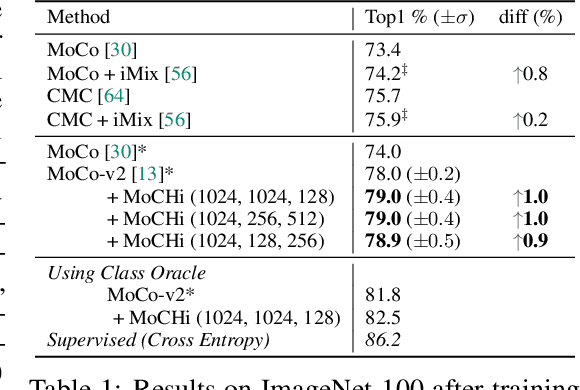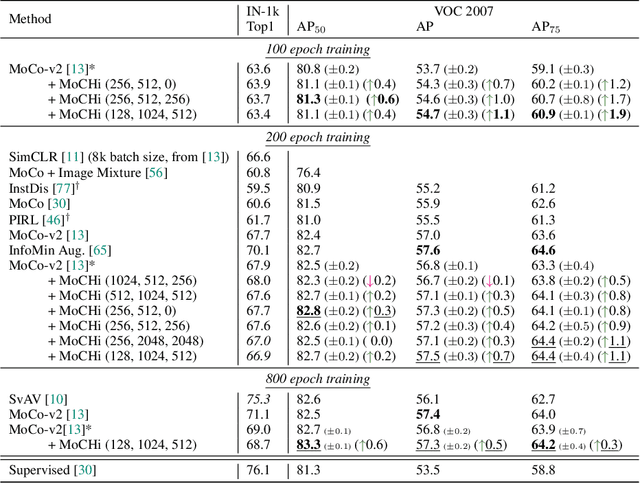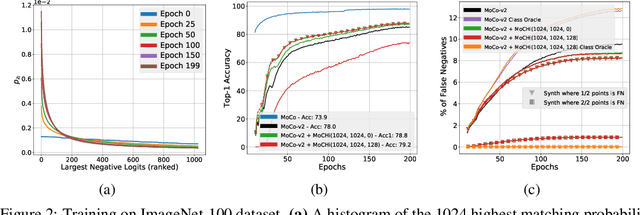Mert Bulent Sariyildiz
DUNE: Distilling a Universal Encoder from Heterogeneous 2D and 3D Teachers
Mar 18, 2025Abstract:Recent multi-teacher distillation methods have unified the encoders of multiple foundation models into a single encoder, achieving competitive performance on core vision tasks like classification, segmentation, and depth estimation. This led us to ask: Could similar success be achieved when the pool of teachers also includes vision models specialized in diverse tasks across both 2D and 3D perception? In this paper, we define and investigate the problem of heterogeneous teacher distillation, or co-distillation, a challenging multi-teacher distillation scenario where teacher models vary significantly in both (a) their design objectives and (b) the data they were trained on. We explore data-sharing strategies and teacher-specific encoding, and introduce DUNE, a single encoder excelling in 2D vision, 3D understanding, and 3D human perception. Our model achieves performance comparable to that of its larger teachers, sometimes even outperforming them, on their respective tasks. Notably, DUNE surpasses MASt3R in Map-free Visual Relocalization with a much smaller encoder.
UNIC: Universal Classification Models via Multi-teacher Distillation
Aug 09, 2024Abstract:Pretrained models have become a commodity and offer strong results on a broad range of tasks. In this work, we focus on classification and seek to learn a unique encoder able to take from several complementary pretrained models. We aim at even stronger generalization across a variety of classification tasks. We propose to learn such an encoder via multi-teacher distillation. We first thoroughly analyse standard distillation when driven by multiple strong teachers with complementary strengths. Guided by this analysis, we gradually propose improvements to the basic distillation setup. Among those, we enrich the architecture of the encoder with a ladder of expendable projectors, which increases the impact of intermediate features during distillation, and we introduce teacher dropping, a regularization mechanism that better balances the teachers' influence. Our final distillation strategy leads to student models of the same capacity as any of the teachers, while retaining or improving upon the performance of the best teacher for each task. Project page and code: https://europe.naverlabs.com/unic
Fake it till you make it: Learning from a synthetic ImageNet clone
Dec 16, 2022



Abstract:Recent large-scale image generation models such as Stable Diffusion have exhibited an impressive ability to generate fairly realistic images starting from a very simple text prompt. Could such models render real images obsolete for training image prediction models? In this paper, we answer part of this provocative question by questioning the need for real images when training models for ImageNet classification. More precisely, provided only with the class names that have been used to build the dataset, we explore the ability of Stable Diffusion to generate synthetic clones of ImageNet and measure how useful they are for training classification models from scratch. We show that with minimal and class-agnostic prompt engineering those ImageNet clones we denote as ImageNet-SD are able to close a large part of the gap between models produced by synthetic images and models trained with real images for the several standard classification benchmarks that we consider in this study. More importantly, we show that models trained on synthetic images exhibit strong generalization properties and perform on par with models trained on real data.
Improving the Generalization of Supervised Models
Jun 30, 2022



Abstract:We consider the problem of training a deep neural network on a given classification task, e.g., ImageNet-1K (IN1K), so that it excels at that task as well as at other (future) transfer tasks. These two seemingly contradictory properties impose a trade-off between improving the model's generalization while maintaining its performance on the original task. Models trained with self-supervised learning (SSL) tend to generalize better than their supervised counterparts for transfer learning; yet, they still lag behind supervised models on IN1K. In this paper, we propose a supervised learning setup that leverages the best of both worlds. We enrich the common supervised training framework using two key components of recent SSL models: multi-scale crops for data augmentation and the use of an expendable projector head. We replace the last layer of class weights with class prototypes computed on the fly using a memory bank. We show that these three improvements lead to a more favorable trade-off between the IN1K training task and 13 transfer tasks. Over all the explored configurations, we single out two models: t-ReX that achieves a new state of the art for transfer learning and outperforms top methods such as DINO and PAWS on IN1K, and t-ReX* that matches the highly optimized RSB-A1 model on IN1K while performing better on transfer tasks. Project page and pretrained models: https://europe.naverlabs.com/t-rex
Concept Generalization in Visual Representation Learning
Dec 10, 2020



Abstract:Measuring concept generalization, i.e., the extent to which models trained on a set of (seen) visual concepts can be used to recognize a new set of (unseen) concepts, is a popular way of evaluating visual representations, especially when they are learned with self-supervised learning. Nonetheless, the choice of which unseen concepts to use is usually made arbitrarily, and independently from the seen concepts used to train representations, thus ignoring any semantic relationships between the two. In this paper, we argue that semantic relationships between seen and unseen concepts affect generalization performance and propose ImageNet-CoG, a novel benchmark on the ImageNet dataset that enables measuring concept generalization in a principled way. Our benchmark leverages expert knowledge that comes from WordNet in order to define a sequence of unseen ImageNet concept sets that are semantically more and more distant from the ImageNet-1K subset, a ubiquitous training set. This allows us to benchmark visual representations learned on ImageNet-1K out-of-the box: we analyse a number of such models from supervised, semi-supervised and self-supervised approaches under the prism of concept generalization, and show how our benchmark is able to uncover a number of interesting insights. We will provide resources for the benchmark at https://europe.naverlabs.com/cog-benchmark.
Hard Negative Mixing for Contrastive Learning
Oct 02, 2020



Abstract:Contrastive learning has become a key component of self-supervised learning approaches for computer vision. By learning to embed two augmented versions of the same image close to each other and to push the embeddings of different images apart, one can train highly transferable visual representations. As revealed by recent studies, heavy data augmentation and large sets of negatives are both crucial in learning such representations. At the same time, data mixing strategies either at the image or the feature level improve both supervised and semi-supervised learning by synthesizing novel examples, forcing networks to learn more robust features. In this paper, we argue that an important aspect of contrastive learning, i.e., the effect of hard negatives, has so far been neglected. To get more meaningful negative samples, current top contrastive self-supervised learning approaches either substantially increase the batch sizes, or keep very large memory banks; increasing the memory size, however, leads to diminishing returns in terms of performance. We therefore start by delving deeper into a top-performing framework and show evidence that harder negatives are needed to facilitate better and faster learning. Based on these observations, and motivated by the success of data mixing, we propose hard negative mixing strategies at the feature level, that can be computed on-the-fly with a minimal computational overhead. We exhaustively ablate our approach on linear classification, object detection and instance segmentation and show that employing our hard negative mixing procedure improves the quality of visual representations learned by a state-of-the-art self-supervised learning method.
Learning Visual Representations with Caption Annotations
Aug 04, 2020



Abstract:Pretraining general-purpose visual features has become a crucial part of tackling many computer vision tasks. While one can learn such features on the extensively-annotated ImageNet dataset, recent approaches have looked at ways to allow for noisy, fewer, or even no annotations to perform such pretraining. Starting from the observation that captioned images are easily crawlable, we argue that this overlooked source of information can be exploited to supervise the training of visual representations. To do so, motivated by the recent progresses in language models, we introduce {\em image-conditioned masked language modeling} (ICMLM) -- a proxy task to learn visual representations over image-caption pairs. ICMLM consists in predicting masked words in captions by relying on visual cues. To tackle this task, we propose hybrid models, with dedicated visual and textual encoders, and we show that the visual representations learned as a by-product of solving this task transfer well to a variety of target tasks. Our experiments confirm that image captions can be leveraged to inject global and localized semantic information into visual representations. Project website: https://europe.naverlabs.com/icmlm.
 Add to Chrome
Add to Chrome Add to Firefox
Add to Firefox Add to Edge
Add to Edge